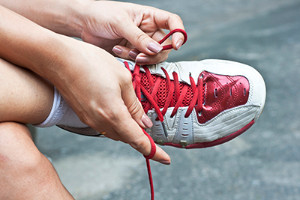
Choosing the right running shoes tailored to different terrains is vital for optimal performance and injury prevention. For road running, prioritize lightweight shoes with ample cushioning to absorb impact on hard surfaces. Look for durable outsoles with good traction for stability and grip on pavement. Trail running demands shoes with rugged outsoles and aggressive tread patterns to navigate uneven terrain and provide traction on dirt, mud, and rocks. Opt for shoes with protective features, such as rock plates or toe guards to shield your feet from sharp objects. In wet or slippery conditions, consider waterproof or water-resistant shoes with quick-drying materials to keep your feet dry and comfortable. When running on tracks, lightweight and responsive shoes with minimal cushioning are ideal for speed and agility. Finally, for cross-country running, choose versatile shoes that offer a balance of cushioning, support, and traction to handle various surfaces. By selecting the appropriate footwear for each terrain, you can enhance your running experience and minimize the risk of injuries. If you are seeking additional information about what type of shoes to choose for your preferred running style, it is suggested that you consult a podiatrist.
If you are a runner, wearing the right running shoe is essential. For more information, contact Dr. Paul Drucker from NYC Foot Care, PC. Our doctor can provide the care you need to keep you pain-free and on your feet.
Choosing the Right Running Shoe for Your Foot Type
To increase performance and avoid the risk of injury, it is important to choose the right running shoe based on your foot type. The general design of running shoes revolves around pronation, which is how the ankle rolls from outside to inside when the foot strikes the ground.
- Neutral runners are able to choose from a wide variety of shoes, including minimalist shoes or even going barefoot.
- Runners who overpronate, or experience an over-abundance of ankle rolling, should choose shoes that provide extra motion control and stability.
- Runners who underpronate, or supinate, have feet that have high arches and lack flexibility, preventing shock absorption. They require shoes with more flexibility and cushion.
If you have any questions please feel free to contact our offices located in 70th Street Manhattan, 60th Street Manhattan, Jamaica, Queens, Plainview, NY and Fair Lawn, NJ . We offer the newest diagnostic and treatment technologies for all your foot and ankle needs.
